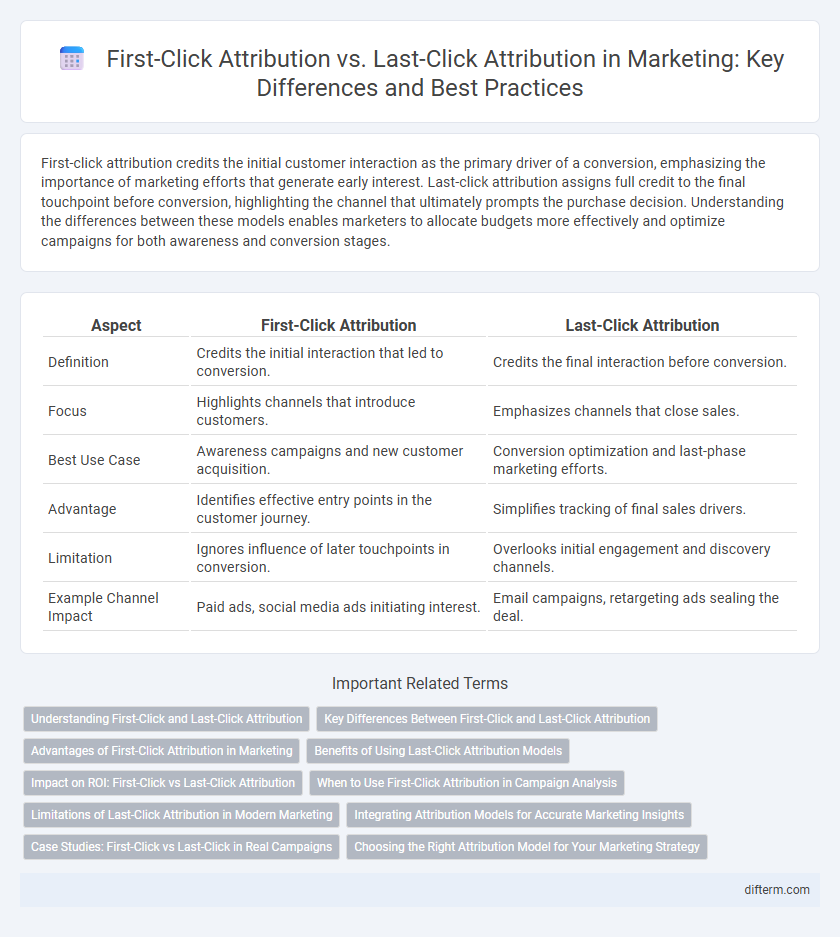First-click attribution credits the initial customer interaction as the primary driver of a conversion, emphasizing the importance of marketing efforts that generate early interest. Last-click attribution assigns full credit to the final touchpoint before conversion, highlighting the channel that ultimately prompts the purchase decision. Understanding the differences between these models enables marketers to allocate budgets more effectively and optimize campaigns for both awareness and conversion stages.
Table of Comparison
| Aspect | First-Click Attribution | Last-Click Attribution |
|---|---|---|
| Definition | Credits the initial interaction that led to conversion. | Credits the final interaction before conversion. |
| Focus | Highlights channels that introduce customers. | Emphasizes channels that close sales. |
| Best Use Case | Awareness campaigns and new customer acquisition. | Conversion optimization and last-phase marketing efforts. |
| Advantage | Identifies effective entry points in the customer journey. | Simplifies tracking of final sales drivers. |
| Limitation | Ignores influence of later touchpoints in conversion. | Overlooks initial engagement and discovery channels. |
| Example Channel Impact | Paid ads, social media ads initiating interest. | Email campaigns, retargeting ads sealing the deal. |
Understanding First-Click and Last-Click Attribution
First-click attribution assigns full credit to the initial interaction that introduced a customer to a brand, highlighting the importance of awareness-driving channels like display ads and social media campaigns. Last-click attribution credits the final touchpoint before conversion, often favoring direct traffic, branded search, or email campaigns that close the sale. Marketers must understand these models to accurately measure channel effectiveness, optimize budget allocation, and improve customer journey analysis.
Key Differences Between First-Click and Last-Click Attribution
First-click attribution credits the initial interaction that led a customer to engage with a brand, emphasizing the importance of awareness and discovery in the marketing funnel. Last-click attribution assigns full value to the final touchpoint before conversion, highlighting actions that directly drive sales or sign-ups. Understanding these key differences helps marketers allocate budget effectively by recognizing which channels initiate interest versus those that close the deal.
Advantages of First-Click Attribution in Marketing
First-click attribution provides valuable insights by highlighting the initial touchpoint that attracts potential customers, enabling marketers to identify effective channels that drive awareness and interest. This model supports strategic budget allocation toward top-performing campaigns, fostering better long-term customer acquisition. Emphasizing first-click attribution enhances the understanding of early-stage user behavior, optimizing marketing efforts for brand discovery and lead generation.
Benefits of Using Last-Click Attribution Models
Last-click attribution models provide clear insight into the final touchpoint that drives conversion, making it easier to judge the effectiveness of specific channels such as paid search or email campaigns. This model simplifies budget allocation by focusing marketing spend on the most accountable interaction leading directly to sales or leads. Businesses relying on last-click attribution benefit from straightforward performance metrics that enhance campaign optimization and increase return on ad spend (ROAS).
Impact on ROI: First-Click vs Last-Click Attribution
First-click attribution assigns full credit for conversions to the initial interaction, providing insights into which channels are best at generating awareness and driving new prospects, which can lead to improved budget allocation for top-of-funnel marketing. Last-click attribution credits the final interaction before conversion, emphasizing the effectiveness of channels that close sales, often resulting in optimized spending on lower-funnel tactics with immediate impact on conversions. Evaluating ROI through both models reveals distinct performance insights, enabling marketers to balance investment between customer acquisition and conversion optimization strategies for maximized return.
When to Use First-Click Attribution in Campaign Analysis
First-click attribution is ideal when understanding the initial touchpoint that drives customer interest and initiates the buying journey is crucial, especially in brand awareness campaigns or new product launches. This model highlights the value of early engagement channels like social media ads or display ads that spark initial curiosity. It is effective for optimizing strategies that aim to attract first-time visitors and nurture prospects through the marketing funnel.
Limitations of Last-Click Attribution in Modern Marketing
Last-click attribution often overlooks the complexity of customer journeys by assigning full credit to the final interaction, ignoring previous touchpoints that influenced the conversion. This narrow focus can result in misleading insights, skewed budget allocations, and missed opportunities for optimizing multi-channel marketing strategies. Modern marketing demands more sophisticated models, such as multi-touch attribution, to accurately capture the impact of all channels and improve campaign effectiveness.
Integrating Attribution Models for Accurate Marketing Insights
Integrating first-click and last-click attribution models enhances marketing insights by capturing the full customer journey, from initial engagement to final conversion. Combining these models allows marketers to allocate budget effectively across channels by recognizing both awareness-driving and conversion-focused touchpoints. Data-driven integration of attribution models improves campaign optimization, driving higher ROI through accurate attribution of marketing efforts.
Case Studies: First-Click vs Last-Click in Real Campaigns
Case studies comparing first-click versus last-click attribution in marketing campaigns reveal significant differences in how credit is assigned across the customer journey. For instance, e-commerce brands implementing first-click attribution observed improved recognition of upper-funnel channels like social media and display ads, which led to optimized budget allocation and increased brand awareness. Conversely, last-click attribution often favored direct and paid search channels, potentially undervaluing awareness-driving efforts and skewing ROI metrics in multi-touch campaigns.
Choosing the Right Attribution Model for Your Marketing Strategy
First-click attribution credits the initial touchpoint that introduced a customer to your brand, emphasizing the importance of awareness channels in driving conversions. Last-click attribution assigns value to the final interaction before purchase, highlighting the role of closing tactics and direct response campaigns. Selecting the right attribution model requires analyzing your customer journey complexity, marketing channels, and campaign goals to ensure accurate measurement and budget allocation for maximum ROI.
First-click attribution vs last-click attribution Infographic

 difterm.com
difterm.com